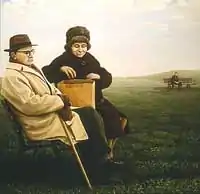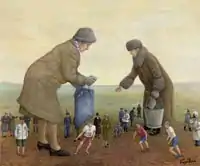Samla Mammas Manna
Samla Mammas Manna was a Swedish progressive rock band often characterized by virtuosic musicianship, circus references and silly humour, similar in many ways to the song-writing style of Frank Zappa. They were one of the founding members of the Rock in Opposition (RIO) movement in the late 1970s. In 1979 they were Fred Frith's backing band on his solo album, Gravity (1980). Musically, they bore a resemblance to the Canterbury scene.
Samla Mammas Manna | |
|---|---|
| Also known as | SMM |
| Origin | Uppsala, Sweden |
| Genres | Progressive rock, Rock in Opposition, avant-prog |
| Years active | 1969–1980, 1990–2008 |
| Labels | Silence |
| Past members | Lars Hollmer Lars Krantz Hasse Bruniusson Coste Apetrea Tatsuya Yoshida Henrik Öberg "Bebben" Eino Haapala Vilgot Hansson |

The original line-up was Lars Hollmer (keyboards), Hasse Bruniusson (drums), Lars Krantz (bass) and Henrik Öberg (percussion). For Måltid, jazz fusion guitarist Coste Apetrea joined the group.
They were on the fringe of the Swedish political "progg" movement, although their lyrics were humorous and not explicitly political.[1] The title of the album Klossa Knapitatet is a play on the Swedish phrase krossa kapitalet, a common slogan in the 1970s that means "crush the capital", and also the title of a seminal progg song by Blå Tåget, called "Staten och Kapitalet (Den ena handen vet vad den andra gör)". Some more serious elements of the progg movement were not amused by this frivolous attitude.
They spent a significant part of the 70s touring in Sweden, but also in other European countries.[2]
The band underwent line-up and name changes over the years (they released albums as Zamla Mammaz Manna and von Zamla), reinventing their sound each time. In 1999, the band reformed under their original name for a one-off release entitled Kaka.[3] In 2002 they reunited again, this time with Japanese musician Tatsuya Yoshida on drums, for some performances and their final album Dear Mamma. The band played their first concerts in the US in August 2003, in Chicago at Schuba's, and at the annual Progday festival in North Carolina.
In 2005 the band opened the international progressive rock festival that took place in Moscow, Russia, InProg 2005.
Hollmer died in December 2008.
Musical style
The musical style of Samla Mammas Manna has been described as a fusion of progressive rock and various national folk styles. [4] This being the result of complex rhythms using instruments not commonly used in the rock genre including the marimba, bouzouki, veena, and accordion.[5]
Having no direct political stand, being neither "a traditional Swedish folk group" nor, "a leftist folk-rock band" as stated by Andrew Jones in his book Plunderphonics, Pataphysics & Pop Mechanics: An Introduction to Musique Actuelle, they freely weaved in and out of the styles of both groups creating their own unique sound.[6]
Discography

as Samla Mammas Manna
- Samla Mammas Manna (1971)
- Måltid (1973)
- Klossa Knapitatet (1974)
- Snorungarnas symfoni (1976)
- Kaka (1999)
- Dear Mamma (2002)
as Zamla Mammaz Manna
- För äldre nybegynnare (1977)
- Schlagerns mystik (1978)
- Familjesprickor (1980)
as von Zamla
- Zamlaranamma (1982)
- No Make Up! (1984)
- ... 1983 (live) (1999)
References
- Gren, Bert (15 April 1994). "Nu Samlas Mammas Manna – bandet uppstår i lyckliga stunder". Göteborgs-Posten.
- Bergström, Karolina (13 August 2016). "Technogubben klär sig i proggkostym". Upsala Nya Tidning (in Swedish). pp. 4–5.
- Backman, Dan (21 May 1999). "Samla Mammas Manna". Svenska Dagbladet (in Swedish).
- Macan, Edward (1997). Rocking the Classics: English Progressive Rock and the Counterculture. Oxford University Press. ISBN 9780195098877.
- Askounes, Michael. "Samla Mammas Manna - Kaka". All About Jazz. Retrieved 21 April 2023.
- Jones, Andrew (1995). Plunderphonics, Pataphysics & Pop Mechanics: An Introduction to Musique Actuelle (1st ed.). SAF Publishing Ltd. ISBN 978-0946719150.